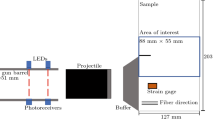Abstract
The effects of water content on the dynamic fracture initiation of notched vinyl ester neat resin samples were examined. The samples were subjected to stress pulses generated by the impact of a projectile launched from an air gun. Two sets of samples of samples were used: the first set was conditioned in an 11 % relative humidity (RH) environment using a saturated salt solution (Lithium Chloride), and the second set was immersed in distilled water. Both sets were kept in their respective environments for 43 days. The dynamic loading conditions were kept constant to analyze the effect of water content on the dynamic fracture initiation of both sample sets. It was observed that the fracture toughness and crack-tip speed showed no significant difference despite a water content differential of 0.49 wt% between the sample sets.










Similar content being viewed by others
References
Mouritz AP, Gellert E, Burchill P, Challis K (2001) Review of advanced composite structures for naval ships and submarines. Compos Struct 53(1):21–42
Dreerman E, Narkis M, Siegmann A, Joseph R, Dodiuk H, Dibenedetto AT (1999) Mechanical behavior and structure of rubber modified vinyl ester resins. J Appl Polym Sci 72(5):647–657
Jacob GC, Starbuck JM, Fellers JF, Simunovic S, Boeman RG (2005) The effect of loading rate on the fracture toughness of fiber reinforced polymer composites. J Appl Polym Sci 96(3):899–904
Gellert EP, Turley DM (1999) Seawater immersion ageing of glass-fibre reinforced polymer laminates for marine applications. Compos A: Appl Sci Manuf 30(11):1259–1265
Lee SB, Rockett TJ, Hoffman RD (1992) Response of unsaturated polyester, vinyl ester, and acrylic resins to water exposure. Polymer 33(17):3691–3697
Apicella A, Migliaresi C, Nicolais L, Iaccarino L, Roccotelli S (1983) The water ageing of unsaturated polyester-based composites: influence of resin chemical structure. Composites 14(4):387–392
Compston P, Jar PYB, Davies P (1998) Matrix effect on the static and dynamic interlaminar fracture toughness of glass-fibre marine composites. Compos Part B 29(4):505–516
Fraga AN, Alvarez VA, Vazquez A, De La Osa O (2003) Relationship between dynamic mechanical properties and water absorption of unsaturated polyester and vinyl ester glass fiber composites. J Compos Mater 37(17):1553–1574
Stevanovic D, Kalyanasundaram S, Lowe A, Jar P-YB (2003) Mode I and mode II delamination properties of glass/vinyl-ester composite toughened by particulate modified interlayers. Compos Sci Technol 63(13):1949–1964
Tucker R, Compston P, Jar P-YB (2001) The effect of post-cure duration on the mode I interlaminar fracture toughness of glass-fibre reinforced vinylester. Compos A: Appl Sci Manuf 32(1):129–134
Compston P, Jar P-YB (1999) The influence of fibre volume fraction on the mode I interlaminar fracture toughness of a glass-fibre/vinyl ester composite. Appl Compos Mater 6(6):353–368
Subramaniyan AK, Sun CT (2007) Toughening polymeric composites using nanoclay: crack tip scale effects on fracture toughness. Compos A: Appl Sci Manuf 38(1):34–43
Compston P, Jar PYB, Burchill PJ, Takahashi K (2002) The transfer of matrix toughness to composite mode I interlaminar fracture toughness in glass-fibre/vinyl ester composites. Appl Compos Mater 9(5):291–314
Weitsman YJ (1995) Effects of fluids on polymeric composites-a review. Technical report, DTIC Document
Harper JF, Naeem M (1989) The moisture absorption of glass fibre reinforced vinylester and polyester composites. Mater Des 10(6):297–300
Lima Sobrinho L, Ferreira M, Bastian FL (2009) The effects of water absorption on an ester vinyl resin system. Mater Res 12(3):353–361
Siriruk A, Penumadu D (2014) Degradation in fatigue behavior of carbon fiber–vinyl ester based composites due to sea environment. Compos Part B 61:94–98
Oguni K, Ravichandran G (2001) Dynamic compressive behavior of unidirectional e-glass/vinylester composites. J Mater Sci 36(4):831–838
Hebert M, Rousseau CE, Shukla A (2008) Shock loading and drop weight impact response of glass reinforced polymer composites. Compos Struct 84(3):199–208
Visco AM, Campo N, Cianciafara P (2011) Comparison of seawater absorption properties of thermoset resins based composites. Compos A: Appl Sci Manuf 42(2):123–130
Visco AM, Brancato V, Campo N (2012) Degradation effects in polyester and vinyl ester resins induced by accelerated aging in seawater. J Compos Mater 46(17):2025–2040
Zukas JA (1982) Impact dynamics. Wiley, New York
Asay JR, Shahinpoor M (1993) High-pressure shock compression of solids. Springer, New York
Theocaris PS, Katsamanis P (1978) Response of cracks to impact by caustics. Eng Fract Mech 10:197–210
Hamouda AMS (2002) The influence of humidity on the deformation and fracture behaviour of PMMA. J Mater Process Technol 124:238–243
Wang C, Eliasson V (2012) Shock wave focusing in water inside convergent structures. Int J Multiphys 6:267–281
Parziale NJ, Schmidt BE, Damazo JS, Wang PS, Hornung HG, Shepherd JE (2015) Pulsed laser diode for use as a light source for short-exposure, high-frame-rate flow visualization. In: 53rd AIAA aerospace sciences meeting. AIAA
Wang C, Qiu S, Eliasson V (2013) Quantitative pressure measurement of shock waves in water using a schlieren-based visualization technique. Exp Tech. doi:10.1111/ext.12068
Konsta-Gdoutos M, Gdoutos EE (1992) Guidelines for applying the method of caustics in crack problems. Exp Tech 16:25–28
Beinert J, Kalthoff JF (1981) Experimental determination of dynamic stress intensity factors by shadow patterns. In: Mechanics of fracture: experimental evaluation of stress concentration and intensity factors, vol 7. Martinus Nijhoff, Hauge
Konsta-Gdoutos M, Gdoutos EE (1992b) Some remarks on caustics in mode I stress intensity factor evaluation. Theor Appl Fract Mech 17(1):47–60
Cheng L, Rosakis AJ, Freund LB (1993) The interpretation of optical caustics in the presence of dynamic non-uniform crack-tip motion histories: a study based on a higher order transient crack-tip expansion. Int J Solids Struct 30(7):875–897
Acknowledgments
The authors gratefully acknowledge the support of the Office of Naval Research through Grant Number N000141310607 (Dr. Y.D.S. Rajapakse, Program Manager) and the National Science Foundation through Grant Number CMMI-1332840. The authors wish to thank Doug Loup, NSWC Carderock Division, for providing the vinyl ester specimens used in this study.
Author information
Authors and Affiliations
Corresponding author
Rights and permissions
About this article
Cite this article
Delpino Gonzales, O., Eliasson, V. Effect of Water Content on Dynamic Fracture Initiation of Vinyl Ester. Exp Mech 56, 637–644 (2016). https://doi.org/10.1007/s11340-015-0028-y
Received:
Accepted:
Published:
Issue Date:
DOI: https://doi.org/10.1007/s11340-015-0028-y




